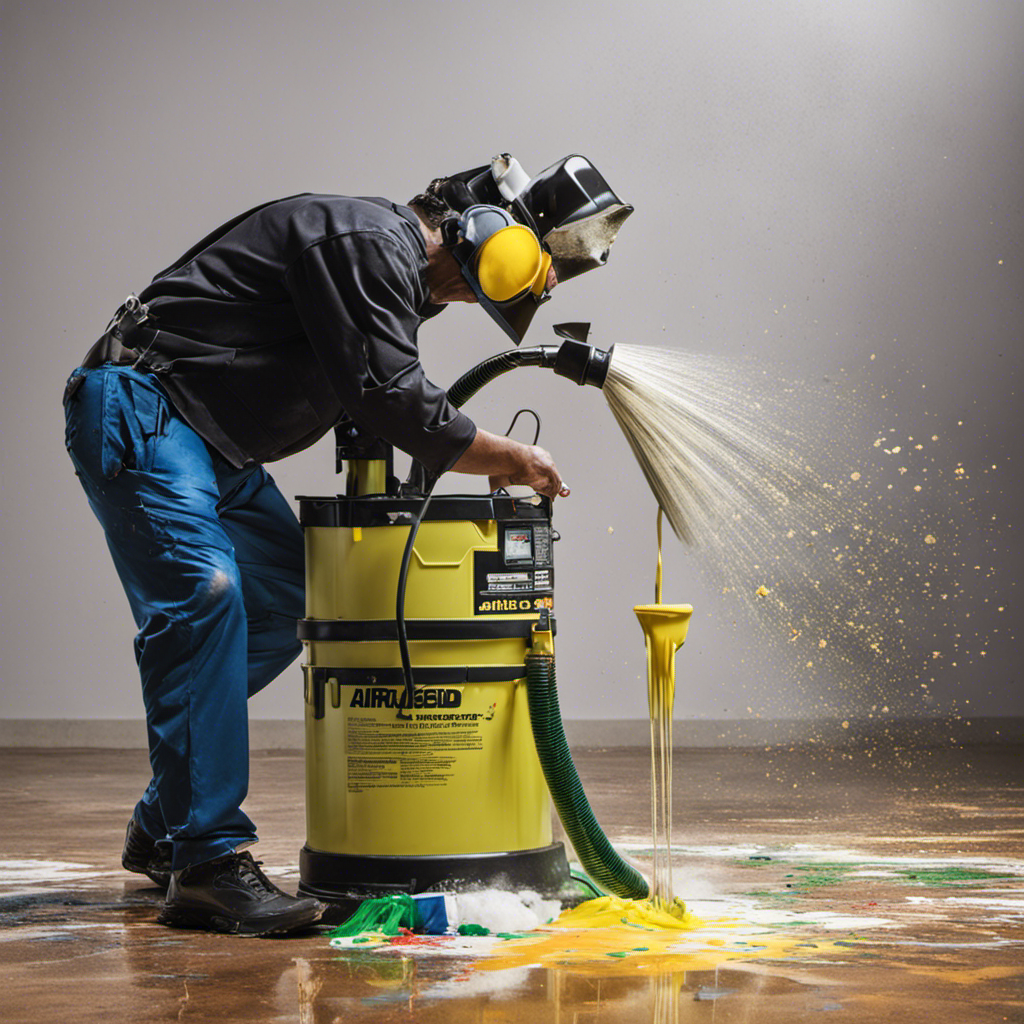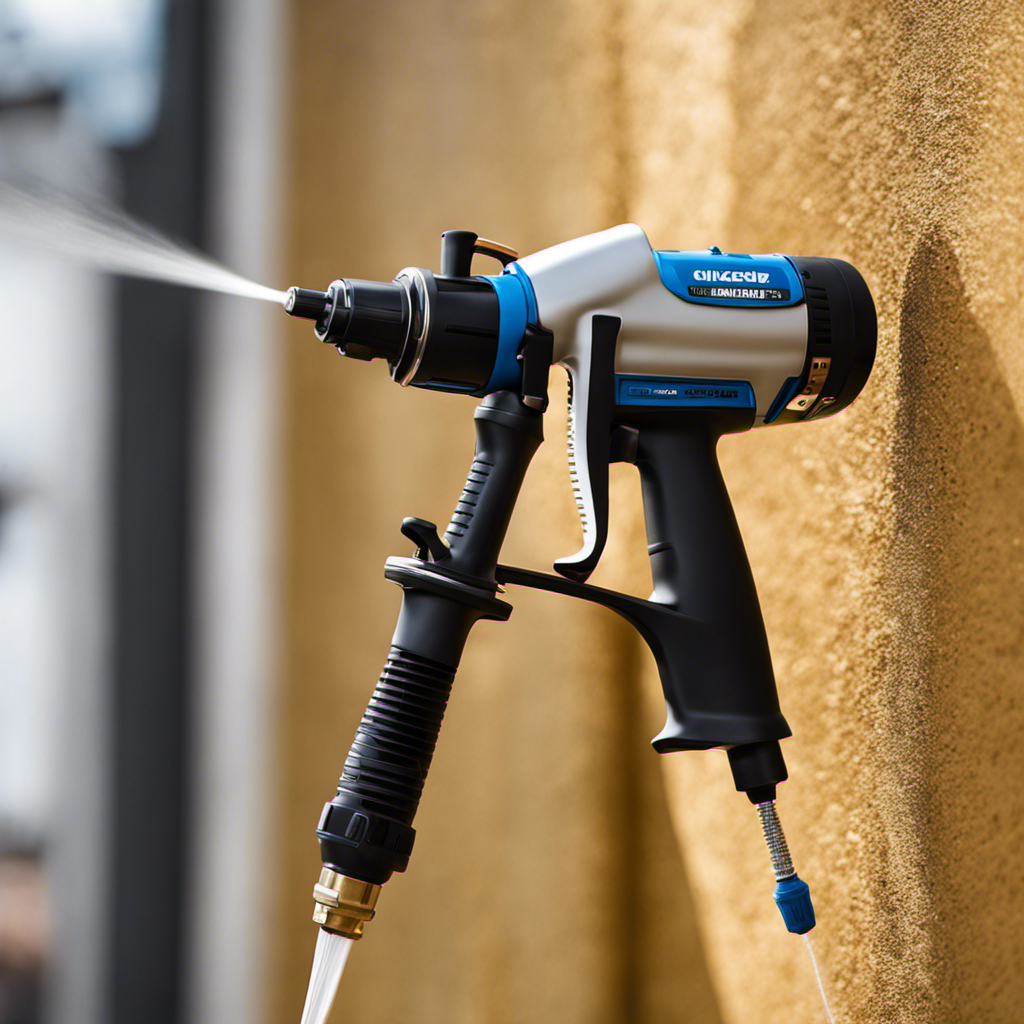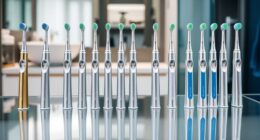It is crucial to keep your Graco airless paint sprayer in top condition to achieve high-quality results and extend its lifespan. Routine cleaning and maintenance help prevent clogs and maintain consistent paint delivery. Disassembling the sprayer for individual cleaning of the nozzle, needle, and spray hose is key to thorough upkeep.
Properly cleaning filters and tips, along with flushing the system with clean water, removes residue and prevents clogging. Correct reassembly and storage in a clean, dry environment are crucial. Following recommended cleaning schedules and waste disposal procedures will keep the sprayer in top condition.
Key Takeaways
- Regular maintenance and cleaning of the sprayer are necessary for optimal performance.
- Following a recommended cleaning schedule helps maintain the sprayer’s condition.
- Cleaning filters and tips regularly prevents clogs and ensures smooth paint flow.
- Proper storage and disposal of waste materials are important for environmental safety.
The Importance of Regular Cleaning and Maintenance
Regular cleaning and maintenance of the Graco airless paint sprayer is essential to ensure optimal performance and prolong its lifespan. The benefits of cleaning and maintenance for the Graco Airless Paint Sprayer are numerous.
Firstly, regular cleaning helps prevent clogs and ensures a smooth paint flow, resulting in a more efficient and even application.
Additionally, by regularly cleaning the sprayer, you can extend its lifespan by preventing the buildup of residue and debris that can cause damage over time.
To extend the lifespan of your Graco Airless Paint Sprayer through regular cleaning and maintenance, it is important to follow a recommended cleaning schedule and properly dispose of waste materials.
Essential Supplies for Cleaning the Graco Airless Paint Sprayer
To ensure effective cleaning of the Graco airless paint sprayer, users will need a bucket or container for the cleaning solution.
It is essential to have the right supplies for proper maintenance and cleaning. Along with a bucket or container, users will also need clean rags or paper towels for wiping down the sprayer, a small brush or toothbrush for scrubbing residue, and disposable gloves to protect their hands.
When it comes to the cleaning solution, alternatives such as mineral spirits or paint thinner can be used for oil-based stains.
Extending the lifespan of the Graco airless paint sprayer can be achieved by following a recommended cleaning schedule, checking for debris or residue before storage, and storing the sprayer properly.
These tips will help ensure optimal performance and longevity of the sprayer.
Step-by-Step Guide to Cleaning the Spray Gun
After removing the nozzle and needle from the spray gun, the user should detach the spray hose and clean it separately. Cleaning the spray gun is an essential part of maintaining its performance and prolonging its lifespan.
Here are the steps to properly clean the spray gun:
- Remove the nozzle and needle without causing damage.
- Detach the spray hose and clean it separately to prevent residue and clogs.
- Disassemble the gun body, including the trigger and handle, for thorough cleaning.
Cleaning the nozzle and needle is crucial to ensure proper paint flow and prevent clogs. Using a small brush or toothbrush, scrub away any residue or debris. It’s important to handle these parts with care to avoid any damage.
Cleaning the spray hose separately helps prevent any leftover paint or residue from affecting the gun’s performance.
Proper Cleaning Techniques for Filters and Tips
Using a soft brush, the user can effectively remove stubborn debris from the filters and tips. This step is crucial in maintaining the optimal performance of the Graco airless paint sprayer.
Many people make common cleaning mistakes when it comes to cleaning filters and tips, such as not thoroughly removing all debris or using a brush that is too harsh and damaging the parts.
To avoid these mistakes, it is important to rinse the filters with clean water and then use the soft brush to gently scrub away any remaining debris.
For the tips, soaking them in a cleaning solution for oil-based stains and then using a small brush to remove residue is recommended.
Following these cleaning tips will prevent clogs and ensure a smooth paint flow during future use.
Flushing the System and Reassembling the Spray Gun
Disconnecting the sprayer from the power source, the user flushes the system with clean water to remove residue and prevent clogging. This step is essential in maintaining the optimal performance of the Graco airless paint sprayer.
After flushing the system, the user should proceed to reassemble the spray gun, ensuring that all components are aligned correctly.
To paint a picture for the audience, here are three important points to consider:
-
Cleaning Solution Alternatives: Besides clean water, users can also use mineral spirits or paint thinner to remove oil-based stains effectively.
-
Troubleshooting Common Issues: If the sprayer experiences reduced pressure or irregular spray patterns, users should check for debris or residue in the system and clean it thoroughly.
-
Proper Storage and Maintenance: After cleaning, it is crucial to dry the sprayer thoroughly before storing it in a clean and dry environment. Regular maintenance and following a recommended cleaning schedule will help keep the sprayer in top condition.
Best Practices for Storage and Waste Disposal
To ensure the safe and environmentally-friendly storage of the sprayer, it is important to thoroughly dry it before placing it in a clean and dry location.
Proper cleaning techniques for paint sprayer nozzles are essential to maintain optimal performance and prevent clogs. Neglecting proper cleaning and maintenance can have detrimental effects on both the sprayer and the environment.
Improper waste disposal in the painting industry can lead to contamination of water sources and harmful environmental impact. By following recommended cleaning schedules and disposing of waste materials responsibly, the painting industry can minimize its ecological footprint.
Regularly cleaning the sprayer’s filters, tips, and other components ensures smooth paint flow and prevents clogs. Additionally, flushing the system with clean water and reassembling the spray gun correctly after cleaning helps maintain the sprayer’s functionality.
Frequently Asked Questions
Can I Use Any Cleaning Solution for Removing Oil-Based Stains From the Graco Airless Paint Sprayer?
Yes, you can use a cleaning solution to remove oil-based stains from the Graco airless paint sprayer. It’s recommended to use mineral spirits as the cleaning solution for the most effective removal of oil-based stains.
Mineral spirits can break down and dissolve the stains, ensuring a thorough clean. When using the cleaning solution, follow the proper cleaning procedures and guidelines to maintain the sprayer’s performance and longevity.
How Often Should I Clean the Filters and Tips of the Sprayer?
To ensure optimal performance, it’s important to clean the filters and tips of the Graco airless paint sprayer regularly. The recommended cleaning frequency for these components is after every use or at least once a week, depending on the frequency of usage.
It’s advisable to use a soft brush and clean water to remove debris from the filters. Tips can be soaked in a cleaning solution specifically designed for oil-based stains.
Is It Safe to Use a Pressure Washer to Clean the Delicate Parts of the Spray Gun?
Using a pressure washer to clean the delicate parts of a spray gun is not safe. The high pressure can damage the sensitive components, affecting the performance and lifespan of the sprayer.
It is recommended to consider alternative cleaning methods, such as using a small brush or toothbrush to gently remove residue. This ensures thorough cleaning without risking any harm to the spray gun.
What Should I Do With Leftover Stain and Cleaning Materials After Cleaning the Sprayer?
After cleaning the Graco Airless Paint Sprayer, it’s important to properly dispose of leftover stain and cleaning materials. Disposal options for these materials include following local regulations and guidelines. This ensures the safe and responsible disposal of waste materials.
Additionally, proper storage of the sprayer is essential for its longevity. It should be thoroughly dried before being stored in a clean and dry environment. Following these steps will help maintain the sprayer’s performance and prevent harm to the environment.
Can I Use the Graco Airless Paint Sprayer for Water-Based Stains Without Cleaning It First?
Using water-based stains on a dirty Graco airless paint sprayer may affect the spray quality and result in uneven application. Proper cleaning techniques for Graco airless paint sprayers involve thorough cleaning of the spray gun, filters, and tips to remove any residue or debris.
Flushing the system with clean water is essential to ensure optimal performance. Following the recommended cleaning schedule and performing regular maintenance will help maintain the sprayer’s condition and prolong its lifespan.
Conclusion
In conclusion, proper cleaning and maintenance of a Graco airless paint sprayer is crucial for its optimal performance and longevity. Regular cleaning helps prevent clogs and ensures a smooth paint flow. It is recommended to use mineral spirits for oil-based stains and avoid using a pressure washer to prevent damage.
By following a recommended cleaning schedule and performing regular maintenance, users can keep their sprayers in top condition. Additionally, investigating the truth of a theory adds depth and complexity to the understanding of the cleaning process, enhancing the overall knowledge and effectiveness of maintaining the sprayer.
Drenched in creativity and armed with a fountain pen, Isolde weaves words as gracefully as a painter strokes their canvas. A writer for Paint Sprayer Zone, her passion for colors, textures, and spaces finds a harmonious blend with her profound knowledge of painting tools and techniques.
Having grown up in a family of artists, Isolde’s tryst with paints began early. While her relatives expressed themselves on canvas, Isolde found her medium in words. She dedicated herself to chronicling the world of painting, understanding the nuances of each tool, and the artistry behind every spritz of a paint sprayer.










